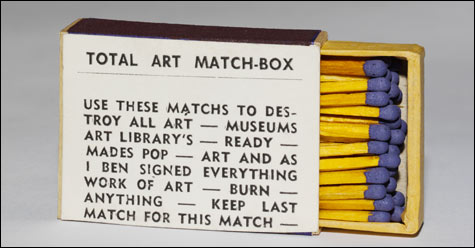Photography and new media loom large on the 2007 art horizon, with cameras pointed in every direction. The family is shot, history is pictured, and our environment is documented. Art created especially for PDAs and a hip video-rental scheme give us visuals on the go. Masters of the Italian Renaissance, on the other hand, set a slower pace.

RECENT HISTORY: Ben Vautier’s Total Art Match Box is part of “Multiple Strategies: Beuys, Maciunas, Fluxus” at the Busch-Reisinger Museum. |
Concern for the unfolding, potentially disastrous consequences of global development comes into unexpectedly beautiful focus in “Edward Burtynsky: The China Series,” at Tufts University Art Gallery (40R Talbot Avenue, Medford; January 19–April 1), with large-scale photographs documenting China’s growth over the past decade. Simultaneously at Tufts, “Altered States: Views of Transition in Recent Photography” presents work by six artists looking at the effects of industry and development in the US and abroad, including Mori Insinger’s chronicle of the gentrification of Boston’s South End.
Rapid industrialization and its effect on life in American cities in the late 19th and early 20th centuries set off a progressive reform movement that inspired the creation of the Social Museum at Harvard, which is committed to documenting urban conditions. “Classified Documents: The Social Museum of Harvard University, 1903–1931,” at Harvard’s Sackler Museum (485 Broadway, Cambridge; January 20–April 22), presents more than 100 original exhibition boards with photographs and illustrations from the Social Museum collection. Harvard also illuminates recent art history: “Multiple Strategies: Beuys, Maciunas, Fluxus,” at the Busch-Reisinger Museum (32 Quincy St, Cambridge; February 24–June 10), scrutinizes works by German artist Joseph Beuys and the international collective Fluxus.
Kara Walker continues her bold reimagining of American history, adding historical documentation to her signature black cutouts in “Harper’s Pictorial History of the Civil War (Annotated),” at the Addison Gallery of American Art (Phillips Academy, 180 Main St, Andover; January 26–April 15). Concurrently, in “Models as Muse,” four contemporary artists inspired by Addison’s famed model ship collection make new video, sculpture, and wall drawings.
The International Council for Science, in conjunction with the World Meteorological Organization, has declared 2007 “International Polar Year,” and in recognition of this important moment, and reflecting the insatiable appetite of artists and explorers alike for pushing the limits of the known world, “Echoes in the Ice: Collages of Polar Explorer by Rik van Glintenkamp,” at Harvard’s Museum of Natural History (26 Oxford St, Cambridge; January 27–April 22), looks at the exploits of 30 heroic and oft-times eccentric Arctic and Antarctic adventurers. Our conflicted relationship with the natural world, which we are both entirely dependent on and determined to mess with, informs “Great Apes,” at Second Gallery (516 East Second St, South Boston; January 20–February 18).
Working in collaboration with members of the Boston science community, experimental Dutch artist Leonard van Munster explores technology’s power to bend things we think of as immutable (that is, through gene manipulation and the like). Current intersections of biology, technology, and art are examined in “It’s Alive! A Laboratory of Biotech Art,” at Montserrat College of Art Gallery (23 Essex St, Beverly; February 15–April 7), with work by 11 artists including Brian Burkhardt, whose Frankenstein-like experimentation with handmade bugs and plants gives Harvard’s glass flowers a run for their money.